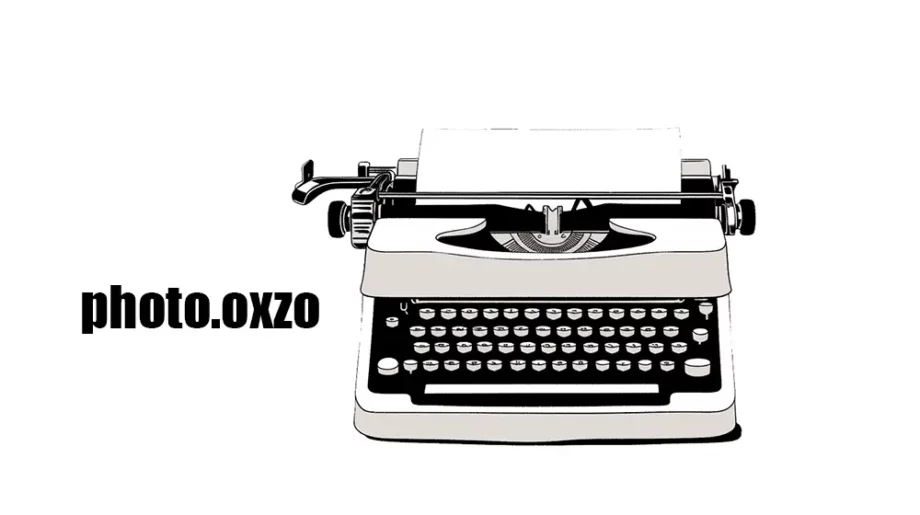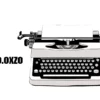Introduction to Nikon Z Series Comparison
In writing this article using ChatGPT, I aim to deepen my understanding of the Nikon cameras covered. I generally post insights like these in the hope that others might find them interesting or new. As I gather more data and approach a buying decision, I will update this article. At 56, I am looking to make some long-term choices. Currently, I’m leaning towards the Z9 for its rugged construction.
I have an extensive collection of camera equipment, including systems from both Micro Four Thirds and Pentax. Yes, that’s right, Pentax. My system revolves around the Monochrome K3-III, a niche experiment that I enjoyed but now feel it’s time to downsize. Although it was an impulse purchase, I believe it’s time to usher in a new era.
My interest in the Z9, Z8, and Z7 II stems from my admiration for the Nikon D850, one of the best full-frame DSLR cameras ever made. The high megapixel counts and dynamic range of these models are particularly appealing. While I need to research how the Z7 II compares to the D850 in terms of autofocus, I am confident that the Z8 and Z9 have surpassed it in that regard.
I plan to include tables with specifications in this write-up, as I enjoy analyzing numbers and making comparisons. One feature I appreciate across all three models is the built-in long exposure modes, which I’ve traditionally used external triggers for. Although not a deal-breaker, it’s a cool feature.
Additionally, I intend to analyze the Z-Mount ecosystem and may compare a fourth body: the most recent Fuji 100-megapixel model. I’ll explore its ecosystem’s extensibility using lens adapters, including the possibility of adapting Nikon lenses. I sold my F mount lenses but consider buying them back at a lower price. With a good collection of manual focus film-era Nikon lenses, a full-frame camera might be the best choice. However, the Fuji’s 100 megapixels offer intriguing possibilities.
The Fuji system’s adaptability and excellent existing lens lineup, including a recently added 500mm prime lens, are appealing for studies of moving water and nature. By comparing more than one camera system with adapters, I can explore a lens mount-agnostic approach. With over 200 vintage lenses dating back to the early 1960s, the key is selecting a versatile body that complements my collection and photographic interests.
One final note on using AI in writing: I have graduate-level reading and writing skills, some would say post-doctoral in certain subjects. I use AI to flesh out ideas and explore thoughts, then revise them completely, which significantly speeds up the process. However, I’ve caught the AI “making up things” and refusing to admit it until I prove it wrong, after which it apologizes. If a reader finds one of these unfortunate “hallucinations” that I missed, please let me know!
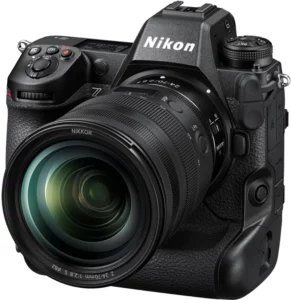
All photos credit to Nikon
Nikon Z9 Review
The Nikon Z9 stands as Nikon’s flagship mirrorless camera, showcasing a multitude of advancements and features that cater to professional photographers and videographers. At its core, the Z9 is equipped with a 45.7MP full-frame stacked CMOS sensor, paired with the Expeed 7 image processor, allowing for remarkable speed and image quality. This combination facilitates shooting at an impressive 20 frames per second (fps) in RAW format and up to 120 fps in JPEG format, albeit at a reduced resolution of 11MP.
One of the standout features of the Z9 is its autofocus system. Nikon has integrated a sophisticated 493-point hybrid phase-detect autofocus system with 3D tracking, a feature previously seen in their DSLRs but significantly enhanced in this mirrorless model. The camera can recognize and track nine different types of subjects, including human faces, eyes, animals, and vehicles, ensuring high accuracy even in dynamic shooting scenarios. This makes the Z9 particularly appealing to sports and wildlife photographers.
Video capabilities are another strong suit of the Z9. It supports 8K video recording at 30 fps and 4K video at up to 120 fps. The camera employs high-efficiency RAW compression to manage file sizes without compromising detail, and it offers multiple recording formats, including 10-bit ProRes 422HQ. Additionally, the Z9’s design includes comprehensive connectivity options, such as an RJ45 ethernet port, USB-C, HDMI, and built-in high-speed Wi-Fi, making it a robust choice for event and broadcast photographers who require reliable and fast data transfer.
Durability and handling are also paramount in the Z9’s design. The body is built from weather-sealed magnesium alloy, ensuring robustness akin to Nikon’s professional DSLRs. It features an integrated vertical grip for better ergonomics during prolonged shoots. The camera’s EN-EL18D battery provides up to 740 shots per charge and supports in-camera USB charging, a feature that adds convenience for on-the-go photographers.
The Z9 is devoid of a mechanical shutter, opting instead for an electronic shutter. This design choice helps achieve faster shooting speeds and reduces mechanical wear. Furthermore, the Z9 introduces a protective sensor shield that activates when the camera is off, protecting the sensor from dust during lens changes, a particularly useful feature for outdoor photography.
In summary, the Nikon Z9 represents a significant leap forward in Nikon’s mirrorless technology, offering a blend of speed, durability, and advanced features that cater to a wide range of professional photography needs. From its high-resolution sensor and rapid shooting capabilities to its sophisticated autofocus system and extensive video options, the Z9 is a powerhouse designed to meet the demands of today’s photographers.
Nikon Z9 Specifications
| Feature | Specification |
|---|---|
| Sensor | 45.7 MP Full-frame Stacked CMOS |
| Image Processor | Expeed 7 |
| ISO Sensitivity | 64-25,600 (expandable to 32-102,400) |
| Autofocus System | 493-point hybrid phase-detect, 3D tracking |
| Continuous Shooting Speed | 20 fps (RAW), 120 fps (11 MP JPEG) |
| Shutter Type | Electronic (no mechanical shutter) |
| Video Recording | 8K at 30 fps, 4K at 120 fps |
| Viewfinder | 0.5-inch OLED, 3.69 million dots |
| LCD Screen | 3.2-inch tilting touchscreen, 2.1 million dots |
| Image Stabilization | 5-axis in-body stabilization |
| Memory Card Slots | 2 x CFexpress Type B / XQD |
| Battery | EN-EL18d, CIPA rated for 740 shots per charge |
| Connectivity | USB-C, HDMI, Ethernet, Wi-Fi, Bluetooth |
| Dimensions | 149 x 149.5 x 90.5 mm |
| Weight | 1340 g |
| Weather Sealing | Yes, fully weather-sealed magnesium alloy body |
| Additional Features | AI-based auto white balance, 9-subject recognition, pre-release burst mode, dual USB-C ports, full-size HDMI, microphone and headphone jacks, 10-pin remote connector |
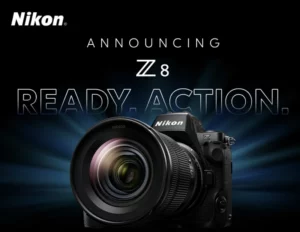
Nikon Z8 Review
The Nikon Z8 emerges as a versatile and more compact alternative to the flagship Z9, retaining much of its powerful features while being more portable. At the heart of the Z8 is the same 45.7MP stacked CMOS sensor found in the Z9, combined with the Expeed 7 processor. This enables impressive shooting capabilities, including 20 fps in RAW and 120 fps in JPEG, maintaining high performance in a smaller body.
Designed with a focus on flexibility and usability, the Z8 offers a robust build that is weather-sealed and features an optional vertical grip for enhanced ergonomics during portrait shooting. The camera is equipped with dual card slots—one for UHS-II SD cards and the other for CFexpress Type B cards—providing high-speed storage options suitable for professional use. The familiar EN-EL15C battery powers the Z8, delivering around 340 shots per charge, with USB-C charging support for added convenience.
In terms of video, the Z8 excels with 8K recording at 30 fps and 4K at 120 fps, providing filmmakers with high-resolution options. Connectivity is comprehensive, featuring two USB-C ports, a full-size HDMI port, 3.5mm microphone and headphone jacks, and built-in Bluetooth and Wi-Fi for seamless integration with smartphones via Nikon’s SnapBridge app. This allows for remote operation and easy transfer of images, catering to the needs of modern photographers who require instant sharing capabilities.
The Z8’s autofocus system mirrors that of the Z9, with 493 phase-detect points and sophisticated subject recognition that includes humans, animals, and vehicles. This makes the Z8 highly reliable in diverse shooting scenarios, from fast-moving sports to detailed wildlife photography. The absence of an integrated vertical grip makes the Z8 notably lighter and more compact than the Z9, weighing in at 910g, which is significantly less than the Z9’s 1340g.
Handling the Z8 feels intuitive, especially for those familiar with Nikon’s professional DSLRs. The control layout is highly customizable, allowing photographers to tailor the camera to their specific needs. Despite a few changes from the Z9, such as the repositioned white balance button and the removal of the drive mode dial, the Z8 maintains a user-friendly interface that supports efficient operation in various shooting conditions.
Overall, the Nikon Z8 stands out as a formidable option for serious photographers seeking the power of the Z9 in a more manageable form. Its blend of high-resolution imaging, advanced autofocus, and extensive video capabilities makes it a strong contender in the professional mirrorless market.
Nikon Z8 Specifications
| Feature | Specification |
|---|---|
| Sensor | 45.7 MP Full-frame Stacked CMOS |
| Image Processor | Expeed 7 |
| ISO Sensitivity | 64-25,600 (expandable to 32-102,400) |
| Autofocus System | 493-point hybrid phase-detect, 3D tracking, Eye AF, Animal Detection AF |
| Continuous Shooting Speed | 20 fps (RAW), 120 fps (11 MP JPEG) |
| Shutter Type | Electronic (no mechanical shutter) |
| Shutter Speed | 1/32,000 to 30 seconds, Bulb, Time |
| Video Recording | 8K at 30 fps, 4K at 120 fps, 10-bit 4:2:2 internal recording |
| Viewfinder | 0.5-inch OLED, 3.69 million dots, 100% coverage |
| LCD Screen | 3.2-inch tilting touchscreen, 2.1 million dots |
| Image Stabilization | 5-axis in-body stabilization |
| Memory Card Slots | 1 x CFexpress Type B / XQD, 1 x UHS-II SD |
| Battery | EN-EL15c, CIPA rated for 340 shots per charge, USB-chargeable |
| Connectivity | 2 x USB-C, HDMI, Ethernet, Wi-Fi, Bluetooth, 10-pin remote connector |
| Dimensions | 144 x 118.5 x 83 mm |
| Weight | 910 g |
| Weather Sealing | Yes, fully weather-sealed magnesium alloy body |
| Picture Control | Auto, Standard, Neutral, Vivid, Monochrome, Portrait, Landscape, Flat, and multiple creative controls |
| Other Features | AI-based auto white balance, 9-subject recognition, pre-release burst mode, sensor shield, HEIF format support, Real-Live Viewfinder, 3D-tracking, Synchro VR, starlight view, Hi-Res Zoom |
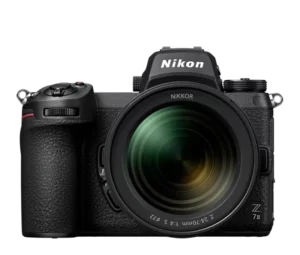
Nikon Z7 II Review
The Nikon Z7 II continues to build on the solid foundation laid by its predecessor, offering high-resolution imaging and advanced features tailored for both enthusiasts and professionals. Equipped with a 45.7MP full-frame BSI CMOS sensor and dual Expeed 6 processors, the Z7 II provides enhanced performance and image quality. This upgrade allows for improved continuous shooting speeds, now capable of up to 10 frames per second (fps) in 12-bit RAW format.
One of the significant enhancements in the Z7 II is the addition of a second memory card slot, supporting both CFexpress Type B and UHS-II SD cards. This not only provides more flexibility for photographers but also ensures a reliable backup solution during shoots. The camera’s buffer has also seen an upgrade, accommodating up to 77 lossless 12-bit RAW images at 10 fps, a substantial improvement from the original Z7.
Autofocus performance has been refined in the Z7 II, featuring a 493-point hybrid phase-detect system. It includes advanced face and eye detection capabilities, ensuring that subjects remain in sharp focus even in challenging conditions. The camera’s ability to focus in low-light conditions down to -3EV, extendable to -4EV with low-light AF, makes it a versatile tool for various shooting environments.
Video capabilities have also been enhanced, with the Z7 II now supporting 4K recording at up to 60 fps. This upgrade allows for high-quality slow-motion footage without sacrificing resolution. The camera offers 10-bit 4:2:2 output via HDMI, making it a strong contender for videographers looking for robust video features in a stills-oriented body.
In terms of build and handling, the Z7 II maintains the ergonomic design and weather-sealed construction of its predecessor. The in-body image stabilization system provides up to 5 stops of shake reduction, contributing to sharp handheld images even in low-light situations. However, it is worth noting that the Z7 II’s stabilization performance is slightly behind competitors like the Canon EOS R5, which offers 8 stops of stabilization.
The Z7 II is powered by the EN-EL15c battery, offering an improved battery life of approximately 360 shots per charge. The camera supports USB-C charging, adding convenience for on-the-go photographers. The Z7 II’s control layout remains user-friendly, with customizable buttons and dials that allow for quick adjustments during shooting.
Overall, the Nikon Z7 II presents a well-rounded package for high-resolution photography and advanced videography. While it may not surpass some of its rivals in every aspect, it offers a balanced performance that caters to a wide range of photographic needs.
Nikon Z7 II Specifications
| Feature | Specification |
|---|---|
| Sensor | 45.7 MP Full-frame BSI CMOS |
| Image Processor | Dual Expeed 6 |
| ISO Sensitivity | 64-25,600 (expandable to 32-102,400) |
| Autofocus System | 493-point hybrid phase-detect, Eye AF, Animal Detection AF |
| Continuous Shooting Speed | 10 fps (12-bit RAW), 9 fps (14-bit RAW) |
| Shutter Type | Mechanical, electronic front-curtain, and electronic shutter |
| Shutter Speed | 1/8,000 to 30 seconds, Bulb, Time, X200 |
| Video Recording | 4K UHD at 60 fps, 1080p at 120 fps |
| Viewfinder | 0.5-inch OLED, 3.69 million dots, 100% coverage |
| LCD Screen | 3.2-inch tilting touchscreen, 2.1 million dots |
| Image Stabilization | 5-axis in-body stabilization |
| Memory Card Slots | 1 x CFexpress Type B / XQD, 1 x UHS-II SD |
| Battery | EN-EL15c, CIPA rated for 360 shots per charge, USB-chargeable |
| Connectivity | USB-C, HDMI, Wi-Fi, Bluetooth |
| Dimensions | 134 x 101 x 70 mm |
| Weight | 705 g |
| Weather Sealing | Yes, fully weather-sealed magnesium alloy body |
| Picture Control | Auto, Standard, Neutral, Vivid, Monochrome, Portrait, Landscape, Flat, and multiple creative controls |
| Other Features | Dual card slots, enhanced Eye and Animal Detection AF, intervalometer, HDR (HLG) support, 4K UHD at 60 fps, 10-bit HDMI output, expanded buffer capacity |
Comparing the Nikon Z9, Z8, and Z7 II: A Detailed Analysis
When comparing the Nikon Z9, Z8, and Z7 II, it becomes clear that each camera body is designed to meet specific needs within the professional and enthusiast photography communities. The differences in features, performance, and price points highlight their unique strengths and the trade-offs that come with each model.
Nikon Z9: The Flagship Powerhouse
The Nikon Z9 stands out as Nikon’s flagship mirrorless camera, equipped with a 45.7MP stacked CMOS sensor and the Expeed 7 image processor. This combination allows for remarkable speed and image quality, with the ability to shoot 20 frames per second (fps) in RAW and up to 120 fps in JPEG at a lower resolution. The Z9’s advanced autofocus system features 493 phase-detect points and can recognize and track nine types of subjects, making it ideal for sports and wildlife photographers.
The Z9’s video capabilities are equally impressive, supporting 8K recording at 30 fps and 4K at 120 fps. It offers extensive connectivity options, including an RJ45 ethernet port, USB-C, HDMI, and built-in Wi-Fi, catering to the needs of event and broadcast photographers. The robust build, weather-sealing, and integrated vertical grip further enhance its usability in demanding environments. However, the Z9’s substantial weight and price tag reflect its positioning as a top-tier professional camera.
Nikon Z8: The Versatile Contender
The Nikon Z8 serves as a more portable alternative to the Z9, retaining much of its powerful features. It shares the same 45.7MP stacked CMOS sensor and Expeed 7 processor, providing similar shooting capabilities with 20 fps in RAW and 120 fps in JPEG. The Z8’s autofocus system is equally sophisticated, featuring 493 phase-detect points and advanced subject recognition.
Despite its smaller and lighter body, the Z8 offers robust build quality and comprehensive connectivity options, including two USB-C ports, a full-size HDMI port, and built-in Wi-Fi and Bluetooth. Its video capabilities mirror those of the Z9, supporting 8K and 4K recording. The absence of an integrated vertical grip makes the Z8 more compact and portable, appealing to photographers who require high performance in a smaller form factor. However, its battery life is shorter compared to the Z9, which may require additional planning for longer shoots.
Nikon Z7 II: The Balanced Performer
The Nikon Z7 II offers a more budget-friendly option while still delivering high-resolution imaging with its 45.7MP full-frame BSI CMOS sensor. It features dual Expeed 6 processors, enhancing its performance with improved continuous shooting speeds of up to 10 fps. The Z7 II’s autofocus system, with 493 phase-detect points and advanced face and eye detection, ensures reliable performance in various shooting conditions.
In terms of video, the Z7 II supports 4K recording at up to 60 fps, providing good quality for videographers. It also offers dual memory card slots, accommodating both CFexpress Type B and UHS-II SD cards for added flexibility. The Z7 II maintains a weather-sealed body with in-body image stabilization, providing 5 stops of shake reduction. While it may not offer the same high-end features as the Z9 and Z8, the Z7 II delivers a well-rounded package for photographers seeking high-resolution capabilities at a lower price point.
Conclusion
In summary, the Nikon Z9, Z8, and Z7 II each cater to different segments of the photography market. The Z9, with its cutting-edge features and robust build, is ideal for professionals requiring top-tier performance and versatility. The Z8 offers a similar feature set in a more compact and portable design, making it a great choice for those who need high performance on the go. The Z7 II provides a balanced option with excellent image quality and advanced features at a more accessible price point. By understanding the unique strengths of each model, photographers can choose the camera that best suits their specific needs and budget.
Nikon Z-Mount Lenses Specifications
| Lens | Focal Length | Max Aperture | Min Aperture | Weight | Filter Size | Lens Elements | Dimensions |
|---|---|---|---|---|---|---|---|
| NIKKOR Z 24-70mm f/4 S | 24-70 mm | f/4 | f/22 | 500 g | 72 mm | 14 elements in 11 groups | 77.5 x 88.5 mm |
| NIKKOR Z 35mm f/1.8 S | 35 mm | f/1.8 | f/16 | 370 g | 62 mm | 11 elements in 9 groups | 73 x 86 mm |
| NIKKOR Z 50mm f/1.8 S | 50 mm | f/1.8 | f/16 | 415 g | 62 mm | 12 elements in 9 groups | 76 x 87 mm |
| NIKKOR Z 24-70mm f/2.8 S | 24-70 mm | f/2.8 | f/22 | 805 g | 82 mm | 17 elements in 15 groups | 89 x 126 mm |
| NIKKOR Z 14-30mm f/4 S | 14-30 mm | f/4 | f/22 | 485 g | 82 mm | 14 elements in 12 groups | 89 x 85 mm |
| NIKKOR Z 85mm f/1.8 S | 85 mm | f/1.8 | f/16 | 470 g | 67 mm | 12 elements in 8 groups | 75 x 99 mm |
| NIKKOR Z 70-200mm f/2.8 VR S | 70-200 mm | f/2.8 | f/22 | 1440 g | 77 mm | 21 elements in 18 groups | 89 x 220 mm |
| NIKKOR Z 24-200mm f/4-6.3 VR | 24-200 mm | f/4-6.3 | f/22-36 | 570 g | 67 mm | 19 elements in 15 groups | 76.5 x 114 mm |
| NIKKOR Z 58mm f/0.95 S Noct | 58 mm | f/0.95 | f/16 | 2000 g | 82 mm | 17 elements in 10 groups | 102 x 153 mm |
| NIKKOR Z 20mm f/1.8 S | 20 mm | f/1.8 | f/16 | 505 g | 77 mm | 14 elements in 11 groups | 84.5 x 108.5 mm |
| NIKKOR Z 50mm f/1.2 S | 50 mm | f/1.2 | f/16 | 1090 g | 82 mm | 17 elements in 15 groups | 89.5 x 150 mm |
| NIKKOR Z 24-50mm f/4-6.3 | 24-50 mm | f/4-6.3 | f/22-36 | 195 g | 52 mm | 11 elements in 10 groups | 73.5 x 51 mm |
| NIKKOR Z MC 50mm f/2.8 Macro | 50 mm | f/2.8 | f/22 | 260 g | 46 mm | 10 elements in 7 groups | 74 x 66 mm |
| NIKKOR Z MC 105mm f/2.8 VR S Macro | 105 mm | f/2.8 | f/32 | 630 g | 62 mm | 16 elements in 11 groups | 85 x 140 mm |
| NIKKOR Z 400mm f/2.8 TC VR S | 400 mm | f/2.8 | f/22 | 2950 g | 46 mm (drop-in) | 25 elements in 19 groups | 156 x 380 mm |
| NIKKOR Z 800mm f/6.3 VR S | 800 mm | f/6.3 | f/32 | 2385 g | 46 mm (drop-in) | 22 elements in 14 groups | 140 x 385 mm |
| NIKKOR Z 600mm f/4 TC VR S | 600 mm | f/4 | f/22 | 3250 g | 46 mm (drop-in) | 26 elements in 20 groups | 160 x 437 mm |
| NIKKOR Z 600mm f/6.3 VR S | 600 mm | f/6.3 | f/32 | 1390 g | 95 mm | 21 elements in 14 groups | 109.5 x 350 mm |
| NIKKOR Z 800mm f/6.3 VR S | 800 mm | f/6.3 | f/32 | 2385 g | 46 mm (drop-in) | 22 elements in 14 groups | 140 x 385 mm |
| NIKKOR Z 24-120mm f/4 S | 24-120 mm | f/4 | f/22 | 630 g | 77 mm | 16 elements in 13 groups | 84 x 118 mm |
| NIKKOR Z 28-75mm f/2.8 | 28-75 mm | f/2.8 | f/22 | 565 g | 67 mm | 15 elements in 12 groups | 73 x 120.5 mm |
| NIKKOR Z 40mm f/2 | 40 mm | f/2 | f/16 | 170 g | 52 mm | 6 elements in 4 groups | 68.5 x 45.5 mm |
| NIKKOR Z 85mm f/1.2 S | 85 mm | f/1.2 | f/16 | 1160 g | 82 mm | 15 elements in 10 groups | 104 x 141.5 mm |
| NIKKOR Z 135mm f/1.8 S Plena | 135 mm | f/1.8 | f/16 | 995 g | 82 mm | 16 elements in 14 groups | 89 x 141 mm |
| NIKKOR Z 28-400mm f/4-8 VR | 28-400 mm | f/4-8 | f/22-45 | 725 g | 77 mm | 21 elements in 15 groups | 84.5 x 141.5 mm |
| NIKKOR Z 50mm f/1.2 S | 50 mm | f/1.2 | f/16 | 1090 g | 82 mm | 17 elements in 15 groups | 89.5 x 150 mm |
Sigma Z-Mount Lenses Specifications
| Lens | Focal Length | Max Aperture | Min Aperture | Weight | Filter Size | Lens Elements | Dimensions |
|---|---|---|---|---|---|---|---|
| Sigma 16mm f/1.4 DC DN Contemporary | 16 mm | f/1.4 | f/16 | 420 g | 67 mm | 16 elements in 13 groups | 72.2 x 94.3 mm |
| Sigma 30mm f/1.4 DC DN Contemporary | 30 mm | f/1.4 | f/16 | 285 g | 52 mm | 9 elements in 7 groups | 70 x 75.3 mm |
| Sigma 56mm f/1.4 DC DN Contemporary | 56 mm | f/1.4 | f/16 | 295 g | 55 mm | 10 elements in 6 groups | 70 x 61.5 mm |
